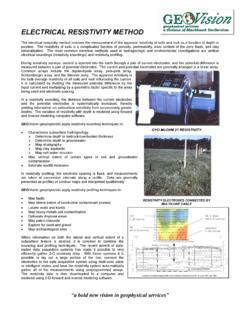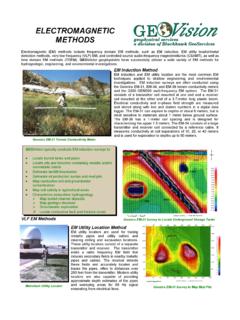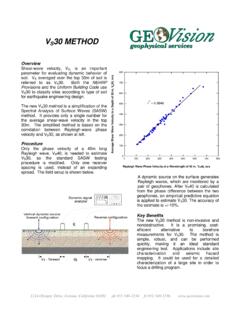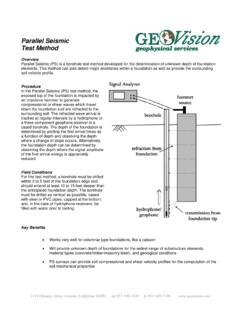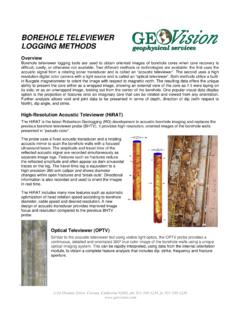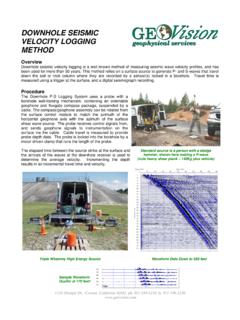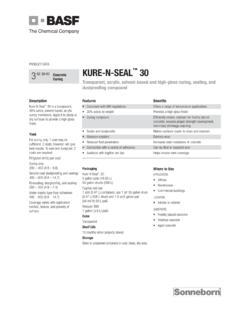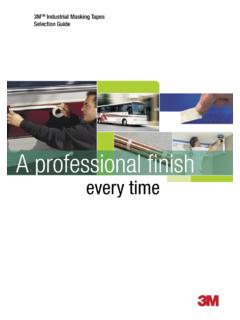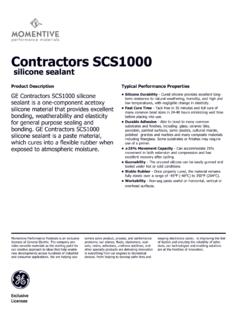Transcription of ACTIVE AND PASSIVE SURFACE WAVE TECHNIQUES
1 1151 Pomona Road, Corona, California 92882 ph. 951-549-1234 fx 951-549-1236 Accelerated Weight Drop ACTIVE AND PASSIVE SURFACE WAVE TECHNIQUES Overview ACTIVE and PASSIVE SURFACE wave TECHNIQUES are relatively new in-situ seismic methods for determining shear wave velocity (VS) profiles. Testing is performed on the ground SURFACE , allowing for less costly measurements than with traditional borehole methods. The basis of SURFACE wave TECHNIQUES is the dispersive characteristic of Rayleigh waves when traveling through a layered medium. Rayleigh wave velocity is determined by the material properties (primarily shear wave velocity, but also to a lesser degree compression wave velocity and material density) of the subsurface to a depth of approximately 1 to 2 wavelengths.
2 As shown in the adjacent diagram, longer wavelengths penetrate deeper and their velocity is affected by the material properties at greater depth. SURFACE wave testing consists of measuring the SURFACE wave dispersion curve at a site and modeling it to obtain the corresponding shear wave velocity profile. ACTIVE SURFACE Wave TECHNIQUES ACTIVE SURFACE wave TECHNIQUES measure SURFACE waves generated by dynamic sources such as hammers, weight drops, electromechanical shakers, vibroseis and bulldozers. These TECHNIQUES include the spectral analysis of SURFACE waves (SASW) and multi-channel array SURFACE wave (MASW) methods.
3 Hammer Energy Sources Electromechanical Shaker Bulldozer Energy Source DISPERSION CURVEMASW Field Setup masking of Wrapped Phase Spectrum and Resulting Dispersion CurveHP Dynamic Signal Analyzer The SASW method is optimized for conducting VS depth soundings. A dynamic source is used to generate SURFACE waves of different wavelengths (or frequencies) which are monitored by two or more receivers at known offsets. An expanding receiver spread is used to avoid near field effects associated with Rayleigh waves and the source-receiver geometry is optimized to minimize body wave signal.
4 A dynamic signal analyzer is typically used to calculate the phase and coherence of the cross spectrum of the time history data collected at a pair of receivers. During data analysis, an interactive masking process is used to discard low quality data and to unwrap the phase spectrum, as shown in the figure below. The dispersion curve (Rayleigh wave phase velocity versus frequency or alternatively wavelength) is calculated from the unwrapped phase spectrum. The MASW field layout is similar to that of the seismic refraction technique . Twenty four, or more, geophones are laid out in a linear array with 1 to 2m spacing and connected to a multi-channel seismograph as shown below.
5 This technique is ideally suited to 2D VS imaging, with data collected in a roll-along manner similar to that of the seismic reflection technique . The source is offset at a predetermined distance from the near geophone and the Rayleigh wave dispersion curve is obtained by a wavefield transformation of the seismic record via the frequency- wavenumber (f-k) or slowness-frequency (p-f) transforms. These transforms are very effective at isolating SURFACE wave energy from that of body waves . The dispersion curve is picked as the peak of the SURFACE wave energy in slowness (or velocity) frequency space as shown.
6 One advantage of the MASW technique is that the wavefield transformation may not only identify the fundamental mode but also higher modes of SURFACE waves . At some sites, particularly those with large velocity inversions, higher SURFACE wave modes may contain more energy than the fundamental mode. SASW Setup Wavefield Transform of MASW data Triangle Array Geometry Dispersion Curve from Array Microtremor Measurements Refraction Microtremor Array Layout Wavefield Transform of REMI Data 12345678910100mPassive SURFACE Wave TECHNIQUES PASSIVE SURFACE wave TECHNIQUES measure noise; SURFACE waves from ocean wave activity, traffic, factories, wind, etc.
7 These TECHNIQUES include the array microtremor and refraction microtremor (REMI) TECHNIQUES . The array microtremor technique typically uses 7 or more or 1-Hz geophones arranged in a two-dimensional array. The most common arrays are the triangle, circle, semi-circle and L arrays. The triangle array, which consists of several embedded equilateral triangles, is often used as it provides good results with a relatively small number of geophones. With this array the outer side of the triangle should be at least as long as the desired depth of investigation. Typically, fifteen to twenty 30-second noise records are acquired for analysis.
8 A technique called spatial autocorrelation (SPAC) is used to obtain the Rayleigh wave dispersion curve. For a particular frequency the phase velocity is equal to that which best fits a first order Bessel function to the SPAC function. The image shown is phase velocity versus frequency showing the degree of fitness of the Bessel function to the SPAC function for a wide velocity and frequency range. The dispersion curve, is the peak (best fit), as shown in the figure below. The refraction microtremor (REMI) technique uses a field layout similar to the seismic refraction method (hence its name).
9 Twenty-four, Hz geophones are laid out in a linear array with a spacing of 6 to 8m and fifteen to twenty 30-second noise records are acquired. A slowness-frequency (p-f) wavefield transform or SPAC function is used to separate Rayleigh wave energy from that of other waves . Because the noise field can originate from any direction, the wavefield transform is conducted for multiple vectors through the geophone array, all of which are summed. The dispersion curve is defined as the lower envelope of the Rayleigh wave energy in p-f space. Because the lower envelope is picked rather than the energy peak (energy traveling along the profile is slower than that approaching from an angle), this technique may be somewhat more subjective than the others, particularly at low frequencies.
10 INTERPRETED DISPERSION CURVE FREQUENCY (HZ)SLOWNESS (SEC/M) WAVESDISPERSION CURVE Depth of Investigation ACTIVE SURFACE wave investigations typically use various sized sledge hammers to image the shear wave velocity structure to depths of up to 15m. Weight drops and electromechanical shakers can often be used to image to depths of 30m. Bulldozers and vibroseis trucks can be used to image to depths as great as 100m. PASSIVE SURFACE wave TECHNIQUES can often image shear wave velocity structure to depths of over 100m, given sufficient noise sources and space for the receiver array.
